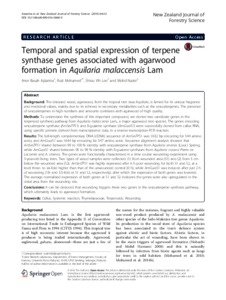Citation
Anor Basah, Azzarina and Mohamed, Rozi and Shiou, Yih Lee and Salleh @ Japri, Mohd Nazre
(2016)
Temporal and spatial expression of terpene synthase genes associated with agarwood formation in Aquilaria malaccensis Lam.
New Zealand Journal of Forestry Science, 46 (12).
pp. 1-13.
ISSN 0048-0134; ESSN: 1179-5395
Abstract
Background
The diseased wood, agarwood, from the tropical tree taxa Aquilaria, is famed for its unique fragrance and medicinal values, mainly due to its richness in secondary metabolites such as the sesquiterpenes. The presence of sesquiterpenes in high numbers and amounts correlates with agarwood of high quality.
Methods
To understand the synthesis of this important compound, we cloned two candidate genes in the terpenoid synthesis pathway from Aquilaria malaccensis Lam., a major agarwood tree species. The genes encoding sesquiterpene synthase (AmSesTPS1) and δ-guaiene synthase (AmGuaiS1) were successfully cloned from callus RNA, using specific primers derived from transcriptomic data, in a reverse transcription PCR reaction.
Results
The full-length complementary DNA (cDNA) sequence of AmSesTPS1 was 1632 bp encoding for 544 amino acids, and AmGuaiS1 was 1644 bp encoding for 547 amino acids. Sequence alignment analysis showed that AmSesTPS1 shared between 99 to 100 % identity with sesquiterpene synthase from Aquilaria sinensis (Lour.) Spreng. while AmGuaiS1 shared between 95 to 99 % identity with δ-guaiene synthases from Aquilaria crassna Pierre ex Lecomte and A. sinensis. The genes were functionally characterised in a time course wounding experiment using 3-year-old living trees. Two types of wood samples were collected: (1) from wounded area (S1) and (2) from 5 cm below the wounded area (S2). AmSesTPS1 was highly expressed after 6 h post wounding for both S1 and S2, at a level three- to six-fold higher than that of the unwounded control (0 h), while AmGuaiS1 was induced after just 2 h of wounding (18- and 5.5-fold at S1 and S2, respectively), after which the expression of both genes was lowered. The average normalised expression of both genes at S1 and S2 indicates the genes were also upregulated in the distal area from the wounding site.
Conclusions
It can be deduced that wounding triggers these two genes in the sesquiterpene synthesis pathway, which ultimately leads to agarwood formation.
Download File
![[img]](http://psasir.upm.edu.my/52932/1.hassmallThumbnailVersion/Temporal%20and%20spatial%20expression%20of%20terpene%20synthase%20genes%20associated%20with%20agarwood%20formation%20in%20Aquilaria%20malaccensis%20Lam.pdf)  Preview |
|
Text
Temporal and spatial expression of terpene synthase genes associated with agarwood formation in Aquilaria malaccensis Lam.pdf
Download (2MB)
| Preview
|
|
Additional Metadata
Actions (login required)
 |
View Item |

